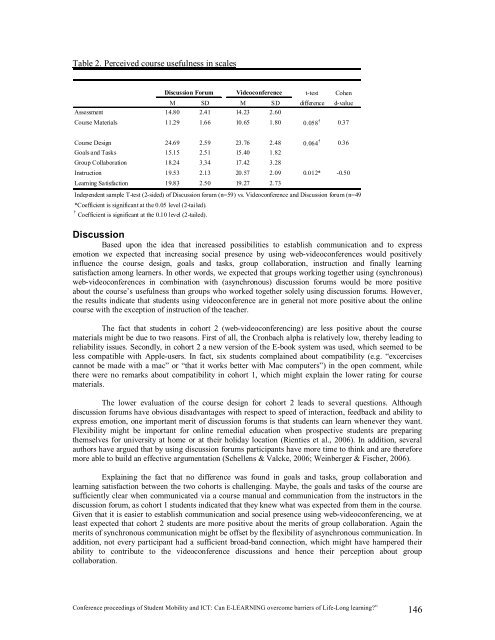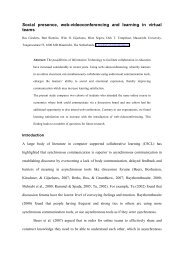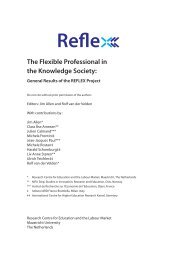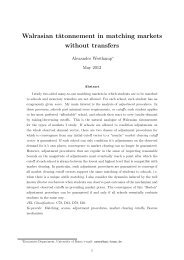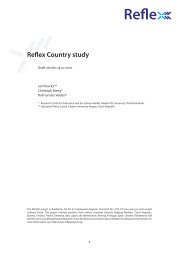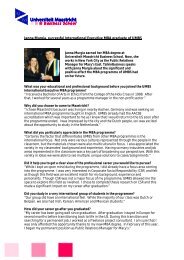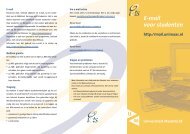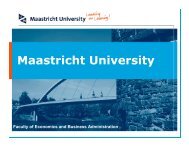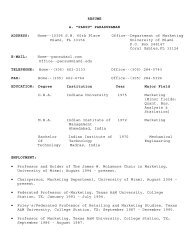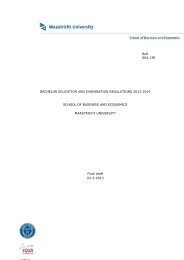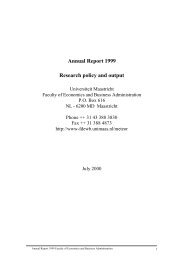proceedings of Student Mobility and ICT: Can E-LEARNING
proceedings of Student Mobility and ICT: Can E-LEARNING
proceedings of Student Mobility and ICT: Can E-LEARNING
You also want an ePaper? Increase the reach of your titles
YUMPU automatically turns print PDFs into web optimized ePapers that Google loves.
Table 2. Perceived course usefulness in scales<br />
Discussion Forum<br />
t-test Cohen<br />
M SD M SD difference d-value<br />
Assessment 14.80 2.41 14.23 2.60<br />
Course Materials 11.29 1.66 10.65 1.80 0.058 † 0.37<br />
Course Design 24.69 2.59 23.76 2.48 0.064 †<br />
Goals <strong>and</strong> Tasks 15.15 2.51 15.40 1.82<br />
Group Collaboration 18.24 3.34 17.42 3.28<br />
Instruction 19.53 2.13 20.57 2.09 0.012* -0.50<br />
Learning Satisfaction 19.83 2.50 19.27 2.73<br />
Independent sample T-test (2-sided) <strong>of</strong> Discussion forum (n=59) vs. Videoconference <strong>and</strong> Discussion forum (n=49).<br />
*Coefficient is significant at the 0.05 level (2-tailed).<br />
† Coefficient is significant at the 0.10 level (2-tailed).<br />
Videoconference<br />
Discussion<br />
Based upon the idea that increased possibilities to establish communication <strong>and</strong> to express<br />
emotion we expected that increasing social presence by using web-videoconferences would positively<br />
influence the course design, goals <strong>and</strong> tasks, group collaboration, instruction <strong>and</strong> finally learning<br />
satisfaction among learners. In other words, we expected that groups working together using (synchronous)<br />
web-videoconferences in combination with (asynchronous) discussion forums would be more positive<br />
about the course’s usefulness than groups who worked together solely using discussion forums. However,<br />
the results indicate that students using videoconference are in general not more positive about the online<br />
course with the exception <strong>of</strong> instruction <strong>of</strong> the teacher.<br />
The fact that students in cohort 2 (web-videoconferencing) are less positive about the course<br />
materials might be due to two reasons. First <strong>of</strong> all, the Cronbach alpha is relatively low, thereby leading to<br />
reliability issues. Secondly, in cohort 2 a new version <strong>of</strong> the E-book system was used, which seemed to be<br />
less compatible with Apple-users. In fact, six students complained about compatibility (e.g. “excercises<br />
cannot be made with a mac” or “that it works better with Mac computers”) in the open comment, while<br />
there were no remarks about compatibility in cohort 1, which might explain the lower rating for course<br />
materials.<br />
The lower evaluation <strong>of</strong> the course design for cohort 2 leads to several questions. Although<br />
discussion forums have obvious disadvantages with respect to speed <strong>of</strong> interaction, feedback <strong>and</strong> ability to<br />
express emotion, one important merit <strong>of</strong> discussion forums is that students can learn whenever they want.<br />
Flexibility might be important for online remedial education when prospective students are preparing<br />
themselves for university at home or at their holiday location (Rienties et al., 2006). In addition, several<br />
authors have argued that by using discussion forums participants have more time to think <strong>and</strong> are therefore<br />
more able to build an effective argumentation (Schellens & Valcke, 2006; Weinberger & Fischer, 2006).<br />
Explaining the fact that no difference was found in goals <strong>and</strong> tasks, group collaboration <strong>and</strong><br />
learning satisfaction between the two cohorts is challenging. Maybe, the goals <strong>and</strong> tasks <strong>of</strong> the course are<br />
sufficiently clear when communicated via a course manual <strong>and</strong> communication from the instructors in the<br />
discussion forum, as cohort 1 students indicated that they knew what was expected from them in the course.<br />
Given that it is easier to establish communication <strong>and</strong> social presence using web-videoconferencing, we at<br />
least expected that cohort 2 students are more positive about the merits <strong>of</strong> group collaboration. Again the<br />
merits <strong>of</strong> synchronous communication might be <strong>of</strong>fset by the flexibility <strong>of</strong> asynchronous communication. In<br />
addition, not every participant had a sufficient broad-b<strong>and</strong> connection, which might have hampered their<br />
ability to contribute to the videoconference discussions <strong>and</strong> hence their perception about group<br />
collaboration.<br />
Conference <strong>proceedings</strong> <strong>of</strong> <strong>Student</strong> <strong>Mobility</strong> <strong>and</strong> <strong>ICT</strong>: <strong>Can</strong> E-<strong>LEARNING</strong> overcome barriers <strong>of</strong> Life-Long learning?” 146<br />
0.36


